Voyage to the Ridge 2022
May 14 - September 2, 2022
Media Resources
This page provides members of the media with information, resources, and multimedia developed in association with the Voyage to the Ridge 2022 series of expeditions.
Importance | Goals | Partners | Explorers | Videos & Images | Background Information | Contacts
From May 11 through September 2, 2022, NOAA Ocean Exploration and partners will conduct a series of three, telepresence-enabled ocean exploration expeditions on NOAA Ship Okeanos Explorer to collect critical baseline information and improve knowledge about unexplored and poorly understood deepwater areas of the Charlie-Gibbs Fracture Zone, Mid-Atlantic Ridge, Azores Plateau, and Puerto Rico.
The first Voyage to the Ridge 2022 expedition will include mapping operations while the second and third expeditions will involve mapping and remotely operated vehicle (ROV) dives:
- Mapping: May 14 - June 7 (Newport, Rhode Island, to St. Johns, Newfoundland)
- ROV and mapping: July 9 - July 30 (Norfolk, Virginia, to Horta, Faial, Azores)
- ROV and mapping: August 6 - September 2 (Horta, Faial, Azores to San Juan, Puerto Rico)
During the second and third expeditions, video from ROV dives will be streamed online in real time from approximately 6:45 a.m. to 5 p.m. ET, July 17 - July 29, August 7 - August 18, and August 25 - September 1. During dives, we expect to explore deep-sea coral and sponge habitats, potential hydrothermal vent and extinct polymetallic sulfide systems, fracture and rift zones, and the water column.
Expedition Importance
Spanning the north-south length of the Atlantic Ocean and stretching an impressive 16,000 kilometers (10,000 miles), the Mid-Atlantic Ridge (MAR) is the longest mountain range in the world and one of the most prominent geological features on Earth. For decades, this largely unexplored underwater mountain range has captivated scientists and the public.
Geologically, the MAR features a divergent plate boundary, volcanism, and frequent earthquakes. Spectacular hydrothermal vents may form where geologic processes provide heat as it rises to the seafloor along the ridge. These vents are known to support diverse chemosynthetic communities. But what life is found at these sites once vents go extinct? Or what life lies beyond the vents, further away from the rift zone? Along the spreading center, are the steep walls and topographic highs suitable habitat for deep-sea corals and sponges? What role does the MAR play in trans-Atlantic biological connectivity? Scientists hope to begin to reveal answers to some of these questions over the course of Voyage to the Ridge 2022, collecting data to support decision-making relative to sensitive marine life and habitats, geological features, and potential resources.
Four Key Things to Know About the Expedition
- We will map, survey, and sample geological features to better understand the geological context of the region and improve knowledge of past and potential future geohazards. The MAR is an active spreading center, slowly spreading at a rate of 2 to 5 centimeters (0.8 to 2 inches) per year. As a result of this spreading activity, earthquakes are common along the ridge, including in the area where we will be exploring. Data collected during Voyage to the Ridge 2022 will increase our understanding of the region’s geological history, which can lend insight into the causes and consequences of past geohazard events, such as submarine earthquakes, including the large magnitude, repeating earthquakes along the Charlie-Gibbs Fracture Zone and earthquakes on the Azores Plateau, and resulting tsunamis. This information can in turn inform our understanding of the potential for future geohazards in the Atlantic Basin as a whole.
- We will use the advanced sonar systems on NOAA Ship Okeanos Explorer to fill critical gaps in mapping data within deepwater areas of the Mid-Atlantic Ridge, Azores Plateau, and Charlie-Gibbs Fracture Zone. As a whole, the ocean covers 70% of our planet’s surface, yet only 20% of the global seafloor has been mapped with modern high-resolution technology. The collection of high-resolution mapping data, including seafloor, sub-bottom, and water column data, is the first step in exploring and thus understanding our ocean and is a key element of every NOAA Ocean Exploration expedition on Okeanos Explorer. Data collected during Voyage to the Ridge 2022 will inform dive targets and guide future exploration efforts, help to establish a baseline assessment of the ocean environment, increase understanding of marine life and habitats to inform management decisions, improve knowledge of past and potential future geohazards, and increase public awareness of ocean issues. Collected data will fill mapping data gaps in support of Seabed 2030 efforts to generate a complete world seafloor map by 2030.
- Voyage to the Ridge 2022 will yield data to help scientists understand the diversity and extent of deep-sea coral and sponge communities along the Mid-Atlantic Ridge, Azores Plateau, and Charlie-Gibbs Fracture Zone. These ecosystems represent some of the most valuable marine ecosystems on the planet, creating structures that provide shelter, food, and nursery habitat to invertebrates and fish. As corals and sponges are fixed in place and generally long-lived and slow growing, they are particularly vulnerable to human activities such as bottom contact fishing gear, seabed mining, and associated environmental change. Recent research has significantly contributed to our understanding and appreciation of corals and sponges, but there is still a great deal to learn about their distribution, diversity, reproduction, and resilience, particularly in the unexplored and poorly understood deepwater areas where we will be exploring.
- We will investigate biogeographic patterns of deep-sea ecosystems and connectivity across the Mid-Atlantic Ridge, Azores Plateau, and Charlie-Gibbs Fracture Zone for use in broader comparisons of deepwater habitats throughout the Atlantic Basin. During parts of Voyage to the Ridge 2022, we will explore the high seas, which cover roughly two-thirds of the ocean and 50% of the planet, yet lie outside the boundaries of any country’s waters and thus are often not prioritized for exploration and remain among the least understood environments on Earth. As marine animals do not recognize the geopolitical boundaries of the world’s ocean and instead live wherever they find suitable habitat, learning more about ecosystems of the high seas through exploration is critical to ensuring the resources within these and surrounding areas are collectively and sustainably managed for the good of the planet. Additionally, understanding how populations of coral, sponge, fish, and other deep-sea species are related across geographically separated locales (a concept known as connectivity) can offer insight into the resiliency of those populations and thus is important for predicting the impacts of human activities on coral communities and for developing solid plans for their protection where needed.
Expedition Goals
Voyage to the Ridge 2022 will address science themes and priority areas put forward by scientists and managers from NOAA, management agencies in the region, and the ocean science community. NOAA priorities for the expedition include a combination of science, education, outreach, and open data objectives that will support management decisions at multiple levels. Specific expedition goals include:
- Improving knowledge of unexplored areas along the region to inform management needs for sensitive habitats, geological features, and potential resources.
- Locating and characterizing deep-sea coral, sponge, and hydrothermal communities.
- Collecting high-resolution bathymetry in areas with no or low-quality sonar data to extend bathymetric mapping coverage in support of Seabed 2030.
- Ground truthing existing bathymetric data, habitat suitability models, seafloor composition models, and inferred hydrothermal vent sites.
- Characterizing water column habitats along the Mid-Atlantic Ridge using acoustics, visual observations, and emerging technologies.
- Collecting data to enhance predictive capabilities for vulnerable marine habitats, seafloor composition, island formation, plate tectonics, hydrothermal vents, critical minerals, and submarine geohazards.
- Investigating biogeographic patterns of deep-sea ecosystems and connectivity across the region for use in broader comparisons of deepwater habitats throughout the Atlantic Basin.
- Mapping, surveying, and sampling geological features, including ocean spreading centers, hydrothermal vents, extinct polymetallic sulfide systems, fracture zones, and rift zones to better understand the geological context of the region and improve knowledge of past and potential future geohazards.
- Engaging a broad spectrum of the scientific community and public in telepresence-based exploration and providing publicly accessible data and information products to spur further exploration, research, and management activities.
Additionally, Voyage to the Ridge 2022 will contribute to NOAA’s Atlantic Seafloor Partnership for Integrated Research and Exploration (ASPIRE), a major multiyear, multinational collaborative field program focused on raising collective knowledge and understanding of the North Atlantic.
Expedition Partners
Led by NOAA Research's NOAA Ocean Exploration, the expedition involves a number of partners including the Office of Marine and Aviation Operations, NOAA Satellite’s National Centers for Environmental Information, and the Global Foundation for Ocean Exploration. This expedition is also receiving extensive participation from international scientists and research initiatives, including representatives from iAtlantic, the University of the Azores, the All-Atlantic Ocean Research Alliance, ATLAS, SponGES, and others.
Explorers
The individuals listed below are the primary leads for the Voyage to the Ridge 2022 expeditions. They coordinate input from multiple scientists and managers participating from shore to plan dives, are several of the voices you hear on the live video feeds, and are the primary participants in outreach events. For a full list of members of the team, visit the Exploration Team page.
Science Leads
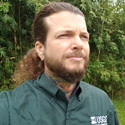
Ashton Flinders
Research Geophysicist, Hawaiian Volcano Observatory, U.S. Geological Survey
Voyage to the Ridge 2022 Expedition 2 - Geology Science Lead
Dr. Ashton Flinders is a research geophysicist for the U.S. Geological Survey at the Hawaiian Volcano Observatory in Hilo, Hawaiʻi. His work focuses on determining the material properties and structures of magma reservoirs in Earth’s crust across a range of tectonic settings. His multi-disciplinary approach integrates classical marine and terrestrial geophysics (gravity, magnetics, seismology) with thermodynamic modeling of phase equilibria. He recently completed a Presidential Management Fellowship, before converting to permanent research staff. Prior to moving to Hawaiʻi in 2019, he was a Mendenhall post-doctoral fellow at the California Volcano Observatory in Menlo Park, California. He holds master's degrees in geology and geophysics from the University of Hawaiʻi at Manoa and ocean engineering with a focus on ocean mapping from the University of New Hampshire’s Center for Coastal and Ocean Mapping. He completed his Ph.D. at the University of Rhode Island’s Graduate School of Oceanography, focusing on applications of high-performance computing and 3D-full waveform seismic tomography at volcanic settings. He has over one year of collective at-sea experience on more than 15 research cruises, ranging from exploration, academic research, sonar quality assurance testing, and mineral exploration.
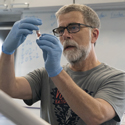
Scott France
Professor, University of Louisiana at Lafayette
Voyage to the Ridge 2022 Expedition 2 - Biology Science Lead
Scott France is serving as the Okeanos Explorer science advisor for the multi-year ASPIRE campaign in the North Atlantic. He studies the evolution of deep-sea invertebrates, in particular deep-sea corals. He was attracted to a career in marine biology when, as an undergraduate fine arts major, he took an elective course in oceanography and was captivated learning about the discovery of deep-sea hydrothermal vents. That new knowledge drove his desire to visit and explore the deep sea himself, and so he switched majors to biology. Scott earned his B.S. in biology from Concordia University (Montreal, Canada) and a Ph.D. in oceanography from the Scripps Institution of Oceanography, University of California, San Diego. He held postdoctoral positions at the Woods Hole Oceanographic Institution, the University of New Hampshire, and Harvard University, and taught evolution at Bowdoin College before joining the faculty of the College of Charleston from 1997-2003. Since 2004, he has been in the Department of Biology at the University of Louisiana at Lafayette. Over his career, he has visited the deep-ocean floor off the Mariana Islands, Hawaii, Galapagos, California, Bahamas, the Central Pacific, Emperor Seamounts, and canyons and seamounts of the western North Atlantic. This will be his fourth expedition as a science lead on NOAA Ship Okeanos Explorer. When not at work, Scott enjoys birding, nature photography, puzzles, and reading.
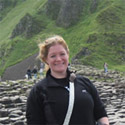
Deb Glickson
Director of the Board on Earth Sciences and Resources and the Water Science and Technology Board, National Academies of Sciences, Engineering, and Medicine
Voyage to the Ridge 2022 Expedition 3 - On-Ship Science Lead
Deb Glickson is a marine geologist with a background in hydrothermal vent geology. She received her Ph.D. in oceanography from the University of Washington in 2007 and also holds a M.S. in geology from Vanderbilt University and a B.S. in geology from the University of Florida. Her doctoral research focused on the magmatic and tectonic evolution of the Endeavour hydrothermal vent fields.
After completing her Ph.D., Deb moved into science policy, where she has used her background in geology and oceanography to provide advice to federal and state governments. She is currently the Director of the Board on Earth Sciences and Resources and the Water Science and Technology Board at the National Academies of Sciences, Engineering, and Medicine, a non-government non-profit.
Deb has sailed on 17 previous deep-sea research expeditions in the Atlantic, Pacific, and Indian ocean basins and has explored the seafloor with autonomous vehicles, remotely operated vehicles, and human-occupied submersibles. She was privileged to be a science lead on the 2016 Deepwater Exploration of the Marianas expedition and a shore-based scientist on the 2005 NOAA telepresence-enabled expedition to the Lost City hydrothermal vent field.
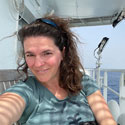
Joana Xavier
Researcher, CIIMAR – Interdisciplinary Centre of Marine and Environmental Research, University of Porto (Portugal)
Voyage to the Ridge 2022 Expedition 3 - Biology Science Lead
Joana Xavier is a researcher and leader of the Deep-Sea Biodiversity and Conservation Research Team at CIIMAR, the Interdisciplinary Centre of Marine and Environmental Research, University of Porto (Portugal), and an invited Associate Professor II of deep-sea biology at the Department of Biological Sciences of the University of Bergen (Norway). She holds a Ph.D. in biology (University of Amsterdam) and a degree in marine biology (University of Azores). Her research focuses on the understanding of basin-scale diversity, biogeographic, and connectivity patterns of deep-sea sponges and sponge habitats using a combination of disciplines (taxonomy, systematics, ecology, and genetics). She also strives to advance the science-policy-society interface, working with local communities to voice their knowledge and perceptions on marine biodiversity, as well as building capacity and tools to support the development and implementation of public policies for sustainable management and conservation of deep-sea vulnerable marine ecosystems.
Joana has participated in 12 expeditions across the North Atlantic and the Arctic, exploring deep-sea habitats on ridges, canyons, and seamounts. In her spare time, she enjoys exploring the sea and land with her family.
Expedition Leads
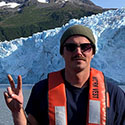
Sam Candio
NOAA Ocean Exploration
Voyage to the Ridge 2022 Expedition 1
Voyage to the Ridge 2022 Expedition 3 - Mapping Lead
Sam Candio is a physical scientist with NOAA Ocean Exploration. He splits his time between conducting field operations aboard NOAA Ship Okeanos Explorer as an expedition coordinator/mapping lead and conducting shoreside responsibilities at the University of New Hampshire Center for Coastal and Ocean Mapping/Joint Hydrographic Center, including mission planning, data quality control, and data archiving. Sam received a bachelor’s degree in marine biology from the University of North Carolina, Wilmington (UNCW), with minors in environmental science and oceanography, and an associate degree in marine technology from Cape Fear Community College. Following graduation, he worked as an instructor for UNCW's MarineQuest, leading a suite of marine science experiential learning programs ranging from the generation of biodiesel from algae to the operation of side-scan sonars and remotely operated vehicles. Prior to signing on with NOAA Ocean Exploration, Sam spent four years aboard NOAA Ship Fairweather, serving as the chief hydrographic survey technician leading coastal bathymetric surveys in areas ranging from the Alaskan Arctic to California’s Channel Islands.

Kasey Cantwell
NOAA Ocean Exploration
Voyage to the Ridge 2022 Expedition 3 - Expedition Coordinator
Kasey Cantwell is the operations chief for the Expeditions and Exploration Division of NOAA Ocean Exploration. Kasey has a master’s degree in marine affairs and policy and marine geology and geophysics and a bachelor’s degree in marine science and biology, both from the University of Miami Rosenstiel School of Marine and Atmospheric Science. Kasey joined NOAA Ocean Exploration in 2012 and is responsible for overseeing the office’s operational portfolio, including telepresence-enabled expeditions conducted aboard NOAA Ship Okeanos Explorer. In her previous role as an expedition coordinator for remotely operated vehicle expeditions, she coordinated over a dozen expeditions and projects, including multidisciplinary expeditions to the Atlantic submarine canyons, the Mariana region, Pacific Remote Islands Marine National Monument, now known as Pacific Islands Heritage Marine National Monument, Glacier Bay National Park, and offshore the southeastern United States. Beyond deep-sea exploration, Kasey’s background includes imagery-based mapping of coral reefs throughout the Caribbean, long-term ecosystem monitoring, and evaluating resource management strategies to improve efficiency and data quality.

Shannon Hoy
NOAA Ocean Exploration
Voyage to the Ridge 2022 Expedition 2 - Mapping Lead
Shannon Hoy is a Mapping Lead with NOAA Ocean Exploration. She has always had a love of the ocean and pursued a bachelor’s degree in marine biology from the College of Charleston and a master’s degree in ocean mapping at the University of New Hampshire’s Center for Coastal and Ocean Mapping. While an undergraduate, she participated in four seafloor mapping expeditions, allowing her to increase her seafloor mapping knowledge and skills, make valuable connections, and travel to exotic places such as Indonesia and Antarctica. On two of these expeditions, she was a NOAA Ocean Exploration explorer-in-training on NOAA Ship Okeanos Explorer! These experiences greatly shaped her career and allowed her to further pursue her passion for ocean exploration. After graduation, Shannon worked for the U.S. Geological Survey’s Submarine Geohazards Group and the University of Bristol’s Paleoceanography group in the United Kingdom. She continued to map throughout these years and began specializing in habitat mapping, using high-resolution technologies and combining her interests in marine biology, geology, and seafloor mapping.

Thomas Morrow
NOAA Ocean Exploration
Voyage to the Ridge 2022 Expedition 3 - Expedition Coordinator (in training)
Thomas Morrow is an Expedition Coordinator with NOAA Ocean Exploration, largely spending his time running mapping missions on NOAA Ship Okeanos Explorer. Thomas is a marine geologist and geophysicist who started his ocean exploration career while earning his bachelor’s degree in geology at the University of Florida. He then moved to the University of Idaho for master’s and doctorate degrees in geological sciences, studying mid-ocean ridges, fracture zones, and hotspot seamounts. Prior to joining NOAA Ocean Exploration, Thomas spent several years as a postdoctoral research fellow at Boston College, coordinating missions to explore the Gofar Transform Fault on Research Vessel (R/V) Atlantis and R/V Thomas G. Thompson.
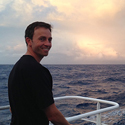
Derek Sowers
NOAA Ocean Exploration
Voyage to the Ridge 2022 - Expedition Manager
Voyage to the Ridge 2022 Expedition 2 - Expedition Coordinator
Derek Sowers has worked as an expedition coordinator and mapping lead for NOAA Ocean Exploration for the past eight years. He completed a bachelor’s degree in environmental science from the University of New Hampshire, a master’s in marine resource management from Oregon State University, and a doctorate in oceanography from the University of New Hampshire. He has 16 years of previous experience working for NOAA's National Estuarine Research Reserve network and the Environmental Protection Agency’s National Estuary Program in both Oregon and New Hampshire. Derek has participated in oceanographic expeditions spanning remote areas of the Arctic, Pacific, and Atlantic oceans. When not at sea, Derek works at the Center for Coastal and Ocean Mapping/Joint Hydrographic Center at the University of New Hampshire.
Videos and Images
Dive highlight videos, short video clips, and photos will be posted online in the expedition gallery as they become available.
Images and video collected during Voyage to the Ridge 2022 are in the public domain, meaning they are free to use without restrictions or additional permissions, provided that the credit information listed in the caption associated with each image or video is included. If space is limited, please credit NOAA Ocean Exploration (preferred) or NOAA.
Please contact Emily Crum for high-resolution footage, b-roll, and other materials posted on the NOAA Ocean Exploration website.
For additional information, please view our online media kit.
NOAA Ocean Exploration Background Information
- NOAA Ocean Exploration is the only federal program dedicated to ocean exploration, making the office uniquely situated to lead partners in delivering critical deep-ocean information to managers, decision makers, scientists, and the public, leveraging federal investments to meet national priorities. In 2021, we are celebrated our 20th anniversary of deep-ocean exploration.
- NOAA Ocean Exploration’s work supports the National Strategy for Mapping, Exploring, and Characterizing the United States Exclusive Economic Zone, which calls for coordinating interagency mapping and exploration activities for the U.S. EEZ, developing new and emerging science and mapping technologies, building public and private partnerships, and completing mapping of the deep water of the U.S. EEZ by 2030 and the near shore by 2040.
- NOAA Ocean Exploration owns the mission equipment being used during the expedition and is coordinating the mission on NOAA Ship Okeanos Explorer. The ship is operated by the NOAA Commissioned Officer Corps and civilians as part of NOAA's fleet managed by the NOAA Office of Marine and Aviation Operations.
- Unlike many other ocean expeditions supported by NOAA, most of the scientists participating in expeditions on Okeanos Explorer remain on shore, thanks to telepresence technology. This technology includes a high-bandwidth satellite connection that enables the transmission of data and video to shore in real time, allowing scientists to participate in the expedition from anywhere in the world.
- Anyone with an internet connection can follow the expedition — LIVE. The same technology that allows scientists around the world to participate in the expedition from shore also enables interested members of the public to experience deep-sea exploration, the wonder of discovery, and the fascination of science in real time through the internet. Multimedia elements and other updates will be added to the website throughout the expedition to keep everyone informed.
- Data collected during expeditions on Okeanos Explorer are quality assured and then made quickly available to scientists and the public. This data collection serves as a unique and centralized national resource of critical ocean information for scientists and resource managers to plan future research, make management decisions, detect natural hazards, improve nautical charts, and more.
Media Contact Information
Emily Crum
Communications Specialist
Email Address: ocean-explore-comms@noaa.gov
David Hall
Public Affairs Officer
Email Address: david.l.hall@noaa.gov